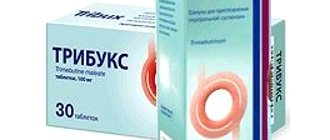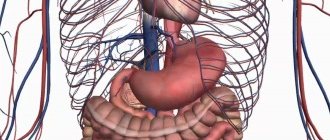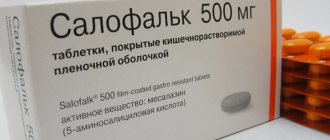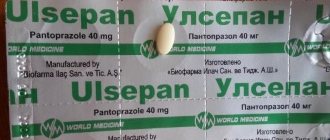Pharmacological properties of the drug Maninil
Pharmacodynamics. Glibenclamide - (1-{4-[2-(5-[chloro-2-methoxybenzamido)ethyl]benzenesulfonyl}-3-cycloxyxylurea) is a hypoglycemic agent. Reduces plasma glucose levels in both patients with type II diabetes mellitus and healthy volunteers by increasing insulin secretion by pancreatic β-cells. The hypoglycemic effect of glibenclamide depends on the glucose concentration in the environment surrounding the β-cells of the pancreatic islets of Langerhans. It inhibits the release of glucagon by α-cells of the pancreas and has an extrapancreatic effect, in particular, it increases the sensitivity of insulin receptors to insulin in peripheral tissues, enhances the action of insulin at the post-receptor level and slows down the breakdown of receptors, but the clinical significance of these phenomena has not yet been studied. Pharmacokinetics. After oral administration, it is quickly and almost completely absorbed. Concomitant food intake does not significantly affect the absorption of glibenclamide, but may lead to a decrease in the concentration of glibenclamide in the blood plasma. Binding to plasma albumin is 98%. Cmax in blood plasma after taking 1.75 mg of glibenclamide is achieved after 1–2 hours and is 100 ng/ml. After 8–10 hours, the concentration in the blood plasma decreases, depending on the dose administered, by 5–10 ng/ml. In the liver, glibenclamide is almost completely converted into two main metabolites: 4-trans-hydroxy-glibenclamide and 3-cis-hydroxy-glibenclamide. Both metabolites are completely excreted from the body in equal quantities with urine and bile within 45–72 hours. T1/2 of glibenclamide is 2–5 hours, but can be extended to 8–10 hours. The duration of action, however, does not correspond to T1/2. In patients with impaired liver function, elimination from blood plasma is slow. In case of renal failure, depending on the degree of renal dysfunction, the excretion of metabolites in the urine increases compensatoryly. With moderately severe renal failure (creatinine clearance - 30 ml/min), the total elimination remains unchanged; in severe renal failure, cumulation is possible.
Use of the drug Maninil
The drug should be prescribed only by a doctor and always with diet correction. Dosing depends on the results of studies of glucose levels in blood plasma and urine. First and subsequent appointments. Therapy is started, if possible, with minimal doses, especially for patients with an increased tendency to hypoglycemia and body weight ≤50 kg. It is advisable to start therapy by prescribing 1/2–1 tablet of Maninil 3.5 (1.75–3.5 mg of glibenclamide) or 1/2 tablet of Maninil 5 (2.5 mg of glibenclamide) once a day. This dose can be gradually increased at intervals of several days to 1 week until the therapeutic dose is reached. The maximum effective dose is 15 mg/day (3 tablets of Maninil 5) or 10.5 mg of micronized glibenclamide (3 tablets of Maninil 3.5). Transferring the patient from the use of other antidiabetic drugs. Transferring to Maninil 3.5 is carried out very carefully and starts with 1/2–1 tablet of Maninil 3.5 (1.75–3.5 mg of glibenclamide per day). Dose selection. In elderly patients, asthenic patients or those with malnutrition, as well as those with impaired renal or hepatic function, the initial and maintenance dose should be reduced due to the risk of hypoglycemia. In addition, when the patient’s body weight decreases or lifestyle changes, it is necessary to decide on dose adjustment. Combination with other antidiabetic agents. Maninil can be prescribed as monotherapy or in combination with metformin. In some cases, if metformin is intolerant, additional use of drugs from the glitazone group (rosiglitazone, pioglitazone) may be indicated. Maninil can also be combined with oral antidiabetic drugs that do not stimulate the release of endogenous insulin by pancreatic β-cells (guare or acarbose). In case of secondary resistance to glibenclamide (decreased insulin production as a result of depletion of β-cells of the islets of Langerhans), combination therapy with insulin can be used. However, when the secretion of the body's own insulin completely stops, insulin monotherapy is indicated. Method of administration and duration of therapy. A daily dose of up to 2 Maninil tablets is taken without chewing with a sufficient amount of liquid (1 glass of water) 1 time per day before breakfast. With a higher daily dose, it is recommended to divide it into 2 doses in a ratio of 2:1 in the morning and evening. It is very important to take the drug at the same time every time. If you miss a dose of the drug, you should not take a double dose to replace the missed dose. The duration of therapy depends on the course of the disease. During treatment, it is necessary to regularly monitor the metabolic status.
Maninila price, where to buy
The price of Maninil 1.75 is 130 rubles per package of 120 tablets.
The cost of Maninil is 3.5 - 170 rubles for the same packaging.
Maninil 5 will also cost about 130 rubles for 120 tablets.
- Online pharmacies in RussiaRussia
- Online pharmacies in UkraineUkraine
- Online pharmacies in KazakhstanKazakhstan
ZdravCity
- Maninil 3.5 tablets 3.5 mg 120 pcs. Menarini-Von Heyden/Berlin Hemi
158 rub. order - Maninil 1.75 tablets 1.75 mg 120 pcs. Berlin-Chemie AG/Menarini Group
123 RUR order
- Maninil 5 tablets 5 mg 120 pcs. Berlin-Chemie AG
120 rub. order
Pharmacy Dialogue
- Maninil (tab. 3.5 mg No. 120) Berlin-Chemie AG/Menarini
RUB 143 order
- Maninil (5 mg tablet No. 120)Berlin-Chemie AG/Menarini
117 RUR order
- Maninil (tab. 1.75 mg No. 120) Berlin-Chemie AG/Menarini
117 RUR order
show more
Pharmacy24
- Maninil 5 mg No. 120 tablets Berlin Chemi AG, Nimechchina
89 UAH.order - Maninil 3.5 mg No. 120 tablets Menarine von Heyden GmbH/Berlin Chemie AG (Menarine Group), Nimecchina/Nimecchina
93 UAH order
PaniPharmacy
- Maninil tab. 3.5 mg No. 120 Germany, Berlin-Chemie
105 UAH order
- Maninil tab. 5mg No. 120 Germany, Berlin-Chemie
94 UAH order
show more
Contraindications to the use of the drug Maninil
If insulin therapy is necessary: insulin-dependent diabetes mellitus (type I), metabolic acidosis, hyperglycemic precoma and coma, decompensation of metabolic disorders during infectious diseases and operations, as well as conditions after pancreatic resection, complete secondary resistance to glibenclamide in type II diabetes mellitus. Other contraindications include: severe liver dysfunction, renal failure with creatinine clearance ≤30 ml/min, hypersensitivity to glibenclamide, Ponceau 4R dye or other components of the drug, as well as to other sulfonylureas, sulfonamide derivatives, diuretics and probenecid; During pregnancy and breastfeeding.
Contraindications
Type 1 diabetes, diabetic precoma , coma , ketoacidosis , hyperosmolar coma , extensive burns, trauma, leukopenia, infectious diseases, pregnancy, microangiopathy, liver, kidney failure, intestinal obstruction.
Prescribed with caution for adrenal insufficiency, alcoholism, febrile syndrome, and thyroid diseases.
Side effects of the drug Maninil
When assessing side effects, the following frequency of occurrence is taken as a basis: very often (≥10%), often (≤10% and ≥1%), sometimes (≤1% and ≥0.1%), rarely (≤0.1 % and ≥0.01%), very rare (≤0.01% or cases unknown): metabolic: often - weight gain, hypoglycemia, which can become protracted and lead to a life-threatening severe hypoglycemic coma. The reasons for this may be an overdose of the drug, impaired liver and kidney function, alcoholism, irregular diet (especially skipping meals), unusual physical activity, impaired carbohydrate metabolism due to diseases of the thyroid gland, anterior pituitary gland and adrenal cortex. Adrenergic symptoms during hypoglycemia may be absent or mild with slowly developing hypoglycemia, peripheral neuropathy, or concomitant therapy with sympatholytics (mainly beta-adrenergic blockers). Symptoms that are precursors of hypoglycemia: hyperhidrosis, increased heart rate, tremor, a sharp feeling of hunger, anxiety, paresthesia in the mouth, pale skin, headache, drowsiness, dyssomnia, impaired coordination of movements, transient neurological disorders (impaired speech and vision, sensory and motor areas ). More detailed information about the state of hypoglycemia is given in the overdose section. With long-term use, hypofunction of the thyroid gland may develop; from the organ of vision: very rarely - visual impairment and accommodation, especially at the beginning of treatment; from the gastrointestinal tract: sometimes - nausea, feeling of fullness/distension in the stomach, vomiting, pain in the abdomen, diarrhea, belching, metallic taste in the mouth. These changes are transient and do not require discontinuation of the drug; from the hepatobiliary system: very rarely - transient increase in AST and ALT, alkaline phosphatase, drug-induced hepatitis, intrahepatic cholestasis, possibly caused by an allergic reaction of a hyperergic type on the part of hepatocytes. These disorders are reversible after discontinuation of the drug, but can lead to life-threatening liver failure; from the skin and subcutaneous tissue: sometimes - itching, urticarial rash, erythema nodosum , measles or maculopapular exanthema, purpura, photosensitivity. These hypersensitivity reactions are reversible, but very rarely can lead to life-threatening conditions, accompanied by shortness of breath and a significant decrease in blood pressure, up to the development of shock. Very rarely - generalized hypersensitivity reactions, which are accompanied by skin rash, arthralgia, chills, proteinuria and jaundice; allergic vasculitis; from the blood and lymphatic system: rarely - thrombocytopenia; very rarely - leukopenia, erythropenia, granulocytopenia (up to the development of agranulocytosis); in some cases - pancytopenia, hemolytic anemia. The listed changes in the blood picture are reversible, but very rarely can pose a threat to life; other side effects: very rarely - weak diuretic effect, reversible proteinuria, hyponatremia, disulfiram-like reaction, cross-allergy with sulfonamides, sulfonamide derivatives and probenecid. Ponceau 4R dye may cause allergic reactions.
Side effects
With an inadequate diet or violation of the dosage regimen, Maninil can lead to hypoglycemia .
Fever, weight gain, allergies, arthralgia, dyspeptic disorders, proteinuria , neurological disorders, cholestasis porphyria cutanea tarda , polyuria, photosensitivity, impaired taste perception, headaches, and fatigue are also noted.
Special instructions for the use of the drug Maninil
Maninil therapy requires regular medical supervision. When using the drug in high doses or when repeated use at short intervals, it is necessary to take into account the longer action of the drug than when used in low doses. It must be remembered that with the simultaneous use of Maninil with clonidine, β-adrenergic receptor blockers, guanethidine and reserpine, the patient’s perception of symptoms that are precursors of hypoglycemia may be disrupted. If there is impaired renal or liver function, or decreased function of the thyroid gland, pituitary gland or adrenal cortex, special caution is required. In elderly patients, there is a risk of developing prolonged hypoglycemia, so glibenclamide is prescribed with extreme caution and under constant monitoring at the beginning of treatment; It is advisable to initially take sulfonylurea drugs with a shorter period of action. If contact with the patient is difficult (for example, with cerebral atherosclerosis), the risk of developing hypoglycemia increases. Long intervals between meals, insufficient carbohydrate intake, unusual exercise, diarrhea or vomiting may increase the risk of hypoglycemia. Alcohol, when taken once in a significant amount and when taken continuously, can unexpectedly enhance or weaken the effect of Maninil. Chronic abuse of laxatives can lead to a deterioration in metabolic health. If the treatment regimen is not followed, the hypoglycemic effect of the drug is insufficient, or during stressful situations, the level of glucose in the blood plasma may increase. Symptoms of hyperglycemia: polydipsia, dry mouth, frequent urination, itching and dry skin, fungal or infectious skin diseases, decreased performance. In severe stressful situations (trauma, surgery, infectious disease, which is accompanied by an increase in body temperature), metabolism may deteriorate, which leads to hyperglycemia, sometimes so severe that it may be necessary to temporarily transfer the patient to insulin therapy. The patient should be informed that the development of other diseases during treatment with Maninil should be immediately reported to the doctor. In case of glucose-6-phosphate dehydrogenase deficiency, treatment with sulfonylureas, including glibenclamide, can cause hemolytic anemia, so it is necessary to consider the use of alternative drugs to sulfonylureas. If you have hereditary galactose intolerance, lactase deficiency or glucose/galactose malabsorption, Maninil should not be used. Use during pregnancy and lactation. Contraindicated. Use in children. Not used. The ability to influence reaction speed when driving vehicles or operating machinery. With hypoglycemia, the ability to concentrate and react quickly may decrease, which must be taken into account when driving vehicles and operating other mechanisms. This is especially important in cases of frequent occurrence of hypoglycemic conditions or lack of adequate perception of symptoms that are precursors of hypoglycemia, and it is necessary to decide on the advisability of driving vehicles or operating machinery.
Drug interactions Maninil
An increase in the effect of glibenclamide (possible development of hypoglycemic conditions) is possible with simultaneous use with other oral antidiabetic drugs (metformin and acarbose) and insulin, ACE inhibitors, anabolic steroids and male sex hormones, antidepressants (fluoxetine, MAO inhibitors), phenylbutazone, β-blockers adrenergic receptors, quinolone derivatives, chloramphenicol, clofibrate and its analogs, disopyramide, fenfluramine, miconazole, PAS, pentoxifylline (when administered parenterally in high doses), perhexiline, pyrazolone derivatives, probenecid, salicylates, fibrates, sulfonamides, tetracycline drugs, tritoqual nom, cytostatics (cyclophosphamide, ifosfamide, trophosfamide). A decrease in the effect of glibenclamide (the development of hyperglycemic conditions) is possible when used simultaneously with acetazolamide, β-adrenergic receptor blockers, barbiturates, diazoxide, chloramphenicol, phenylbutazone, oxyphenbutazone, azopropanone, sulfinpyrazone, miconazole, pheniramidol, sulfonamides, diuretics, glucagon, etc. oniazide, GCS, nicotinates, phenothiazine derivatives, phenytoin, rifampicin, thyroid hormones, female sex hormones (gestagens, estrogens), sympathomimetics. H2 receptor antagonists can both weaken and enhance the hypoglycemic effect of drugs. Alcohol abuse can enhance or weaken the hypoglycemic effect of glibenclamide. In some cases, pentamidine can lead to severe hypo- or hyperglycemia. The effect of coumarin derivatives can be either enhanced or weakened. Sympatholytic agents, such as β-adrenergic blockers, reserpine, clonidine and guanethidine, when used chronically, can help lower blood glucose levels and mask the symptoms of hypoglycemia.
Analogs of Maninila
Level 4 ATC code matches:
Gliclazide
Glidiab
Glyurenorm
Glimepiride
Amyx
Glibenclamide
Amaryl
Diabetes
Analogs include Glibamide and Glibenclamide .
Overdose of the drug Maninil, symptoms and treatment
Acute and chronic overdose of glibenclamide can cause the development of severe, prolonged and life-threatening hypoglycemia. Hypoglycemia can develop due to skipping meals, increased physical activity, and drug interactions. Symptoms of hypoglycemia: severe feeling of hunger, nausea, vomiting, general weakness, anxiety, hyperhidrosis, tachycardia, tremor, mydriasis, muscle hypertonicity, headache, sleep disturbances, endocrine psychosyndrome (irritability, aggressiveness, depression, depression, impaired concentration, confusion , coordination disorders, primitive automatisms - grimacing, grasping movements, chomping, convulsions, focal symptoms - hemiplegia, aphasia, diplopia, drowsiness, coma, disturbance of the central regulation of breathing and activity of the cardiovascular system). As hypoglycemia progresses, loss of consciousness (hypoglycemic coma) is possible; characterized by wet and cold skin upon palpation, tachycardia, hyperthermia, motor agitation, hyperreflexia, the appearance of a positive Babinski reflex and the development of paresis and convulsions. Treatment. Mild hypoglycemia (without loss of consciousness) can be eliminated by the patient on his own by taking approximately 20 g of glucose, sugar or carbohydrate-rich food. In case of accidental overdose and in the presence of contact with the patient, it is necessary to induce vomiting, perform gastric lavage (in the absence of convulsive readiness), prescribe adsorbents and administer intravenous glucose solution. In case of severe hypoglycemia (with loss of consciousness), it is necessary to immediately catheterize the vein. 40–100 ml of 40% glucose solution is administered intravenously as a bolus, followed by an infusion of 5–10% glucose solution, and if venous catheterization is impossible, 1–2 mg of glucagon is administered intramuscularly or subcutaneously. If the patient does not regain consciousness, the above measures are repeated and, if necessary, intensive therapy is carried out. To prevent relapses of hypoglycemia after restoration of consciousness over the next 24–48 hours, carbohydrates are prescribed orally (20–30 g immediately and every 2–3 hours) or a prolonged intravenous infusion of 5–20% glucose solution is performed. You can administer 1 mg of glucagon IM every 6 hours for 48 hours. Carry out regular monitoring of glycemic levels for at least 48 hours after elimination of a severe hypoglycemic state. If, in the event of a significant overdose (for example, during suicidal attempts), consciousness is not restored, a continuous infusion of 5–10% glucose solution is performed, the desired plasma glucose concentration is approximately 200 mg/dL. After 20 minutes, a re-infusion of 40% glucose solution is possible. If the clinical picture does not change, it is necessary to carry out a differential diagnosis of coma and simultaneously treat cerebral edema (dexamethasone, sorbitol). Glibenclamide is not excreted from the body during hemodialysis.





